AUDI ALLROAD 2000 User Guide
Manufacturer: AUDI, Model Year: 2000, Model line: ALLROAD, Model: AUDI ALLROAD 2000Pages: 306, PDF Size: 9.95 MB
Page 11 of 306
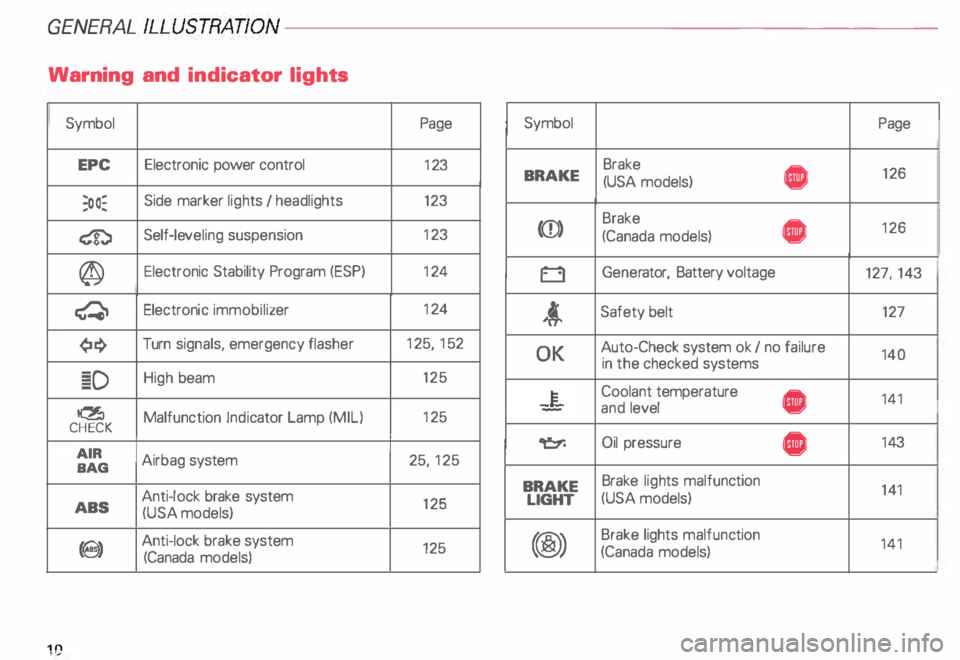
GENERA L
ILL USTR ATION----------------------
Warning and indicator lights
Symbol Page Symbol
Page
EPC Electronic
power control
123 Brake
• 126
BRAKE
(USA models)
;oo� Side
marker lights I headlights 123
� Self-le
veling suspension 12
3 (CD) Brake
• 12
6
(Canada models)
@ Electronic
Stability Program (ESP) 12
4
0 Gener
ator, Battery voltage
127, 143
� Electronic
immobilizer 12
4
t Safety
belt 127
¢!:} Turn
signals, emergency flasher 12
5, 152
� D High
beam 125
� Malfunction Indicator Lamp (MIL) 12
5
CHECK
AIR Airbag system 25, 125
BAG OK
Auto-Check
system ok I no failure
140
in the checked systems
-�- Coolant
temperature
• 141
and level
� Oil pressure
• 14
3
ABS Anti-lock
brake system
125
(USA models) BRAKE
Brake
lights malfunc tion
141
LIGHT (USA
models)
9) Anti-lock
brake system
125
(Canada models) (@) Brake
lights malfunc tion
141
(Canada models)
10
Page 12 of 306

----------------------------------------------GENERALILLUSTRA nON
Symbol
�
0 rp
w
iU
�N
�ENSOR
8 18
�[) =i•
�D 0$ Headlights
I tail lights
malfunction
Brake pads worn
Washer fluid level low
Fuel level low
Engine oil level low
Engine oil sensor defective
Speed warning
Dynamic headlight dimmer control
not functioning
Front fog lights
Rear fog light Page
14 3
143 143
143
144
144
144
14 4
149
149 Note
If one of the lights marked with 0 comes on suddenly while you
are driving, move a safe distance off the road. Turn off the engine,
turn the emergency flasher on and use other warning devices to
alert other motorists. Go to listed page in your Owner's Manual for
explanations.
11
Page 13 of 306

12
Page 14 of 306
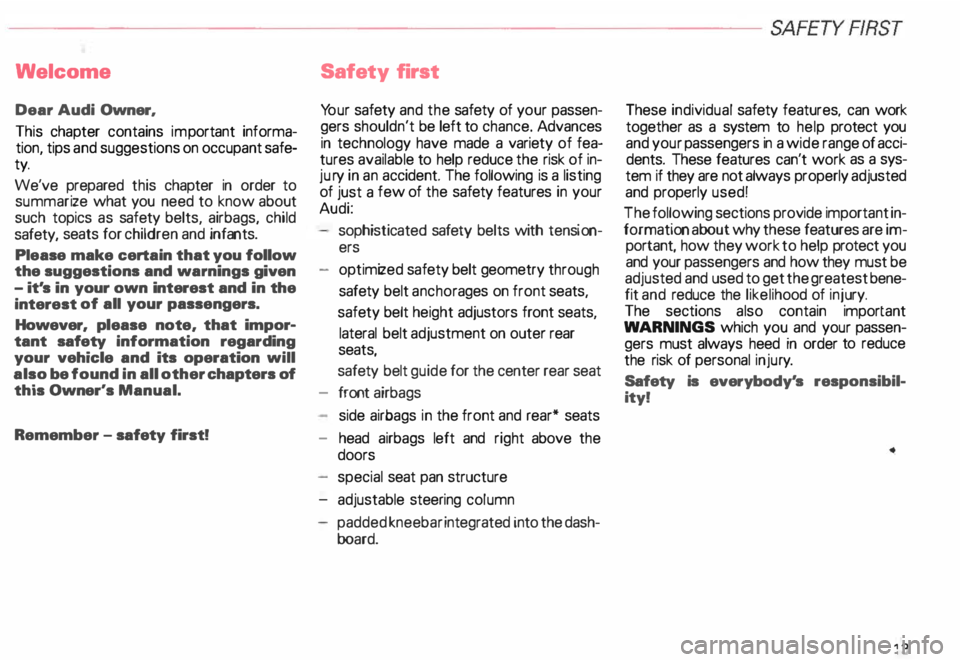
--------------------------------------------------SAFETYRRST
Welcome Dear Audi Owner,
This chapter contains important informa
tion, tips and suggestions on occupant safe
ty.
We've prepared this chapter in order to
summarize what you need to know about
such topics as safety belts, airbags, child
safety, seats for children and infants.
Please make certain that you follow
the suggestions and warnings given
- it's in your own interest and in the
interest of all your passengers.
However, please note, that impor
tant safety information regarding
your vehicle and its operation will
also be found in all other chapters of
this Owner's Manual.
Remember -safety first! Safety
first
Yo ur safety and the safety of your passen
gers shouldn't be left to chance. Advances
in technology have made a variety of fea
tures available to help reduce the risk of in
jur y in an accident. The following is a listing
of just a few of the safety features in your
Audi:
sophisticated safety belts with tension
ers
optimized safety belt geometry through
safety belt ancho rages on front seats,
safety belt height adjustors front seats,
lateral belt adjustment on outer rear
seats,
safety belt guide for the center rear seat
- front airbags
side airbags in the front and rear* seats
- head airbags left and right above the
doors
special seat pan structure
- adjustable steering column
padded kneebar integrated into the dash
board. These
individual safety features, can work
together as a system to help protect you
and your passengers in a wide range of acci
dents. These features can't work as a sys
tem if they are not always properly adjusted
and properly used!
The following sections provide important in
formation about why these features are im
portant, how they work to help protect you
and your passengers and how they must be
adjusted and used to get the greatest bene
fit and reduce the likelihood of injury.
The sections also contain important
WA RNINGS which you and your passen
gers must always heed in order to reduce
the risk of personal injury.
Safety is everybody's responsibil
ity!
1'> ....
Page 15 of 306
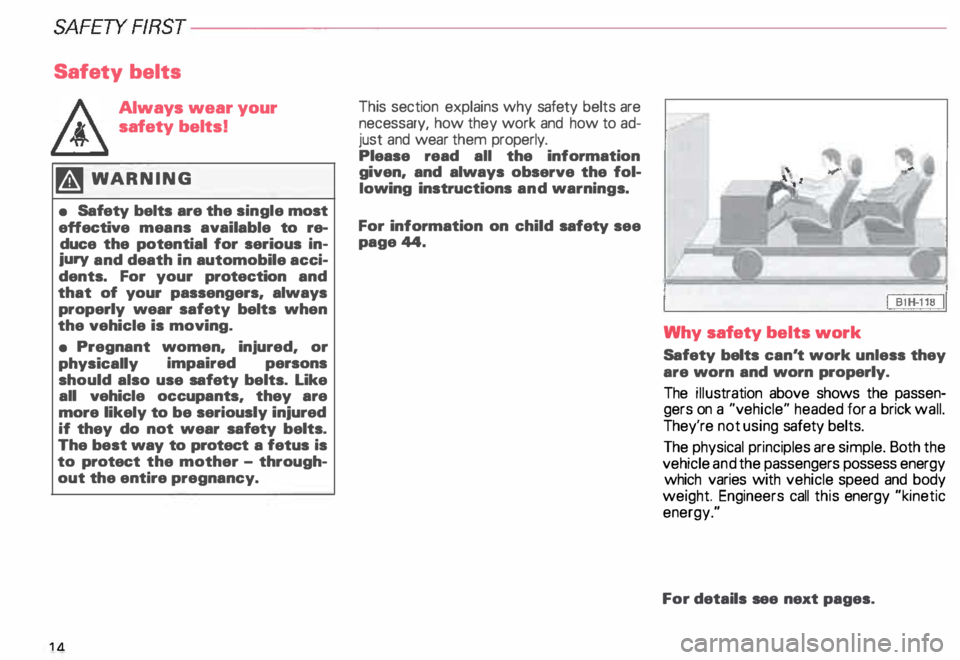
SA
FETY RRST-----------------------------------------------------
Safety belts
J:\. Always wear your
ffi safety belts!
� WARNING
• Safety belts are the single most
effective means available to re
duce the potential for serious in
iury and death in automobile acci
dents. For your protection and
that of your passengers. always
properly wear safety belts when
the vehicle is moving.
• Pregnant women. iniured, or
physically impaired
persons
should also use safety belts. Like
all vehicle occupants, they are
more likely to be seriously iniured
if they do not wear safety belts.
The best way to protect a fetus is
to protect the mother - through
out the entire pregnancy.
1.11. This
section explains why safety belts are
necessary, how they work and how to ad
just and wear them properly.
Please read all the information
given. and always observe the fol
lowing instructions and warnings.
For information on child safety see
page 44.
Why safety belts work
Safety belts can't work unless they
are worn and worn properly.
The illustration above shows the passen
gers on a "vehicle" headed for a brick wall.
They're not using safety belts.
The physical principles are simple. Both the
vehicle and the passengers possess energy
which varies with vehicle speed and body
weight. Engineers call this energy "kinetic
energy."
For details see next pages.
Page 16 of 306
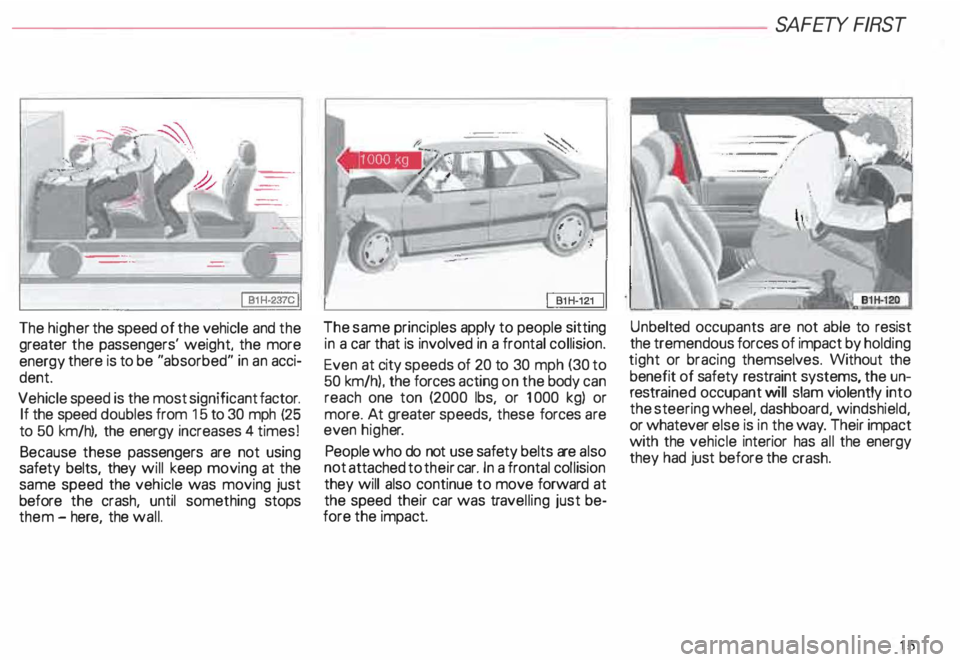
The
higher the speed of the vehicle and the
greater the passengers' weight, the more
energy there is to be "absorbed" in an acci
dent.
Vehicle speed is the most significant factor.
If the speed doubles from 15 to 30 mph (25
to 50 km/hl. the energy increases 4 times!
Because these passengers are not using
safety belts, they will keep moving at the
same speed the vehicle was moving just
before the crash, until something stops
them -here, the wall. The same
principles apply to people sitting
in a car that is involved in a frontal collision.
Even at city speeds of 20 to 30 mph (30 to
50 km/h), the forces acting on the body can
reach one ton (2000 lbs, or 1 000 kg) or
more. At greater speeds, these forces are
even higher.
People who do not use safety belts are also
not attached to their car. In a frontal collision
they will also continue to move forward at
the speed their car was travelling just be
fore the impact. SA
FETY FIRST
Un belted occupants are not able to resist
the tremendous forces of impact by holding
tight or bracing themselves. Without the
benefit of safety restraint systems, the un
restra ined occupant will slam violently into
the steering wheel, dashboard, windshield,
or whatever else is in the way. Their impact
with the vehicle interior has all the energy
they had just before the crash.
15
Page 17 of 306
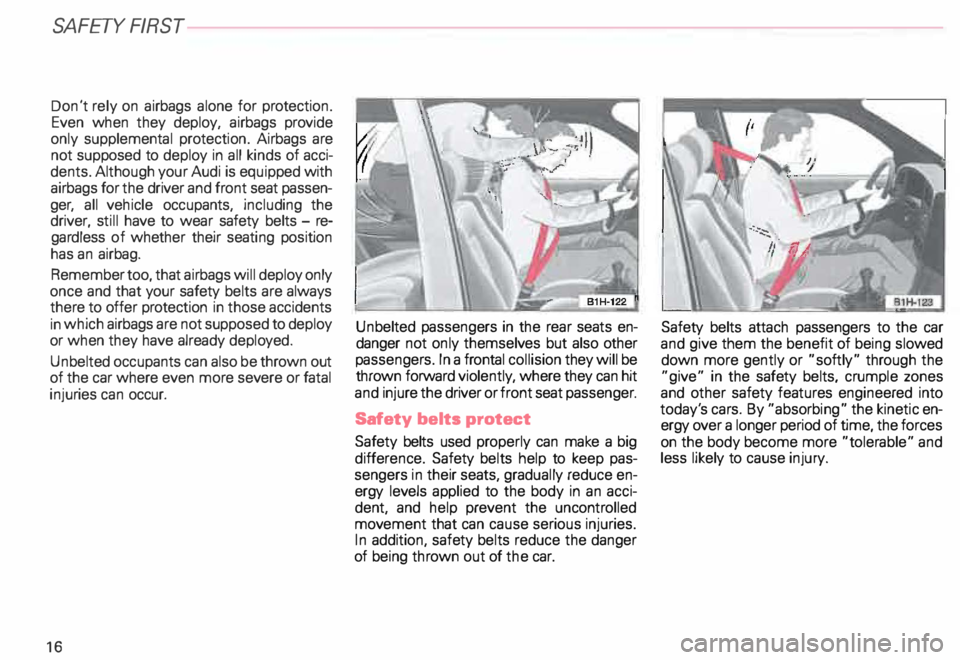
SA
FETY FIRST
Don't rely on airbags alone for protection.
Even when they deploy, airbags provide
only supplemental protection. Airbags are
not supposed to deploy in all kinds of acci
dents. Although your Audi is equipped with
airbags for the driver and front seat passen
ger, all vehicle occupants, including the
driver, still have to wear safety belts- re
gardless of whether their seating position
has an airbag.
Remember too, that airbags will deploy only
once and that your safety belts are always
there to offer protection in those accidents
in which airbags are not supposed to deploy
or when they have already deployed.
Unbelted occupants can also be thrown out
of the car where even more severe or fatal
injuries can occur.
16 Unbelted
passengers in the rear seats en
danger not only themselves but also other
passengers. In a frontal collision they will be
thrown forward violently, where they can hit
and injure the driver or front seat passenger.
Safety belts protect
Safety belts used properly can make a big
difference. Safety belts help to keep pas
sengers in their seats, gradually reduce en
ergy levels applied to the body in an acci
dent, and help prevent the uncontrolled
movement that can cause serious injuries.
In addition, safety belts reduce the danger
of being thrown out of the car. Safety
belts attach passengers to the car
and give them the benefit of being slowed
down more gently or "softly" through the
"give" in the safety belts, crumple zones
and other safety features engineered into
today's cars. By "absorbing" the kinetic en
ergy over a longer period of time, the forces
on the body become more "tolerable" and
less likely to cause injury.
Page 18 of 306
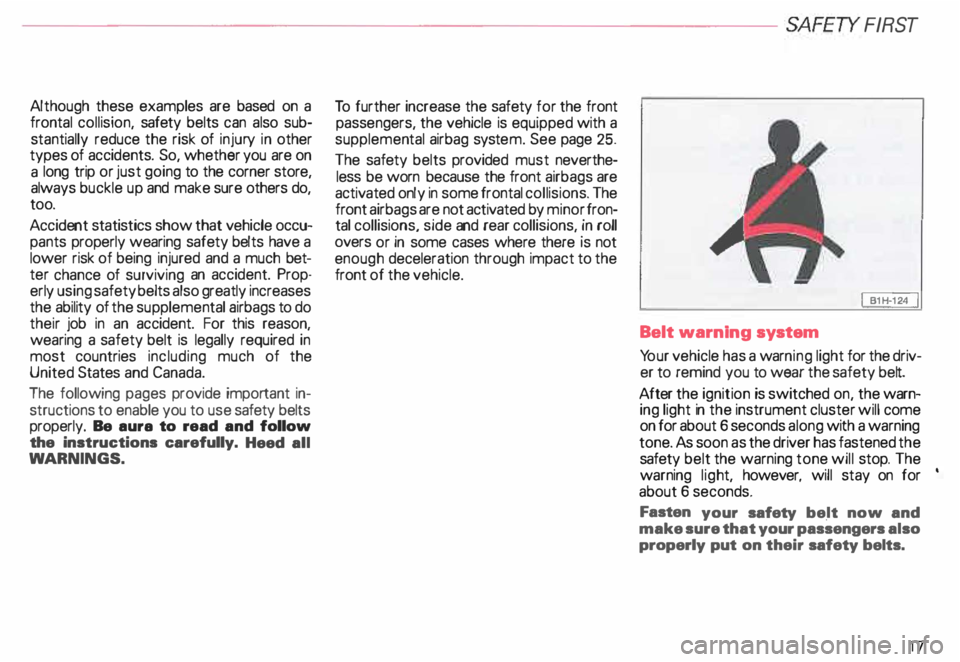
--------------------------SAFETY FIRST
Although
these examples are based on a
frontal collision, safety belts can also sub
stantially reduce the risk of injury in other
types of accidents. So, whether you are on
a long trip or just going to the corner store,
always buckle up and make sure others do,
too.
Accident statistics show that vehicle occu
pants properly wearing safety belts have a
lower risk of being injured and a much bet
ter chance of surviving an accident. Prop
erly using safety belts also greatly increases
the ability of the suppleme ntal airbags to do
their job in an accident. For this reason,
wearing a safety belt is legally required in
most countries including much of the
United States and Canada.
The following pages provide important in
structions to enable you to use safety belts
properly. Be aura to read and follow
the instructions carefully. Heed all
WA RNINGS. To
further increase the safety for the front
passengers, the vehicle is equipped with a
supplemen tal airbag system. See page 25.
The safety belts provided must neverthe
less be worn because the front airbags are
activated only in some frontal collisions. The
front airbags are not activated by minor fron
tal collisions, side and rear collisions, in roll
overs or in some cases where there is not
enough deceleration through impact to the
front of the vehicle.
I B1H-124 I
Belt warning system
Yo ur vehicle has a warn ing light for the driv-
er to remind you to wear the safety belt
After the ignition is switched on, the warn
ing light in the instrument cluster will come
on for about 6 seconds along with a warning
tone. As soon as the driver has fastened the
safety belt the warning tone will stop. The
warning light, however, will stay on for '
about 6 seconds.
Fasten your safety be.lt now and
make sure that your passengers also
properly put on their safety belts.
17
Page 19 of 306
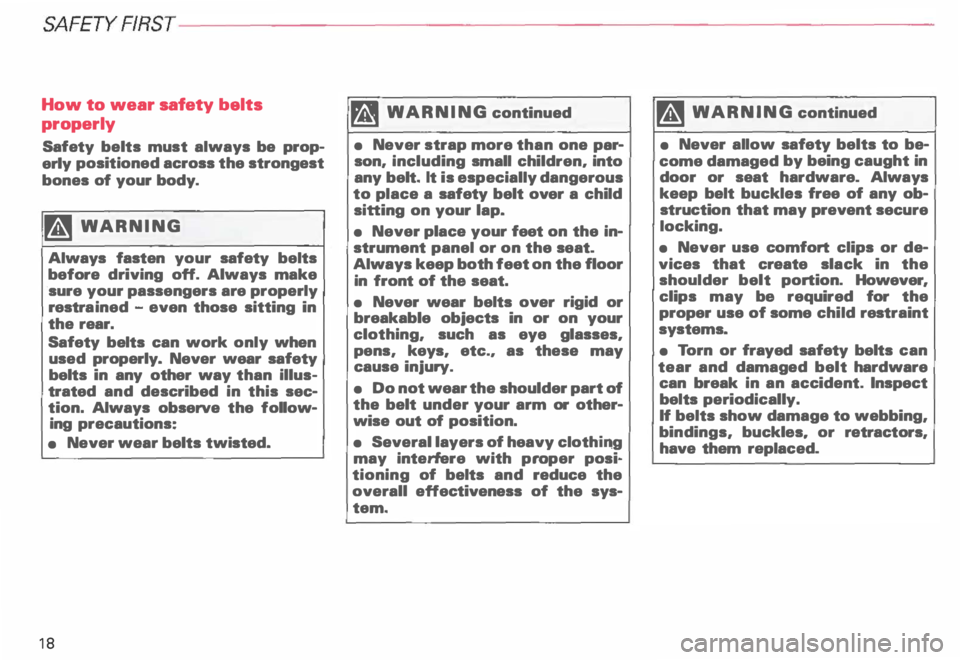
SAFETY RRST---------------------------------------------------
How to wear safety belts
properly
Safety belts must always be prop
erly positioned across the strongest
bones of your body.
�W ARNING
Always fasten your safety belts
before driving off. Always make
sure your passengers are properly
restra ined -even those sitting in
the rear.
Safety belts can work only when
used properly. Never wear safety
belts in any other way than illus
trated and described in this sec
tion. Always observe the follow
ing precautions:
• Never wear belts twisted.
18 '41
WARNING continued
• Never strap more than one par
son, including small children, into
any belt. It is especially dangerous
to place a safety belt over a child
sitting on your lap.
• Never place your feet on the in
strument panel or on the seat.
Always keep both feet on the floor
in front of the seat.
• Never wear belts over rigid or
breakable objects in or on your
clothing, such as eye glasses,
pens, keys, etc., as these may
cause injury.
• Do not wear the shoulder part of
the belt under your arm or other
wise out of position.
• Several layers of heavy clothing
may interfere with proper posi
tioning of belts and reduce the
overall effectiveness of the sys
tem. �
WARNING continued
• Never allow safety belts to be
come damaged by being caught in
door or seat hardware. Always
keep belt buckles free of any ob
struction that may prevent secure
locking.
• Never use comfort clips or de
vices that create slack in the
shoulder belt portion. However,
clips may be required for the
proper use of some child restraint
systems.
• To rn or frayed safety belts can
tear and damaged belt hardware
can break in an accident. Inspect
belts periodically.
If belts show damage to webbing,
bindings, buckles. or retractors,
have them replaced.
Page 20 of 306
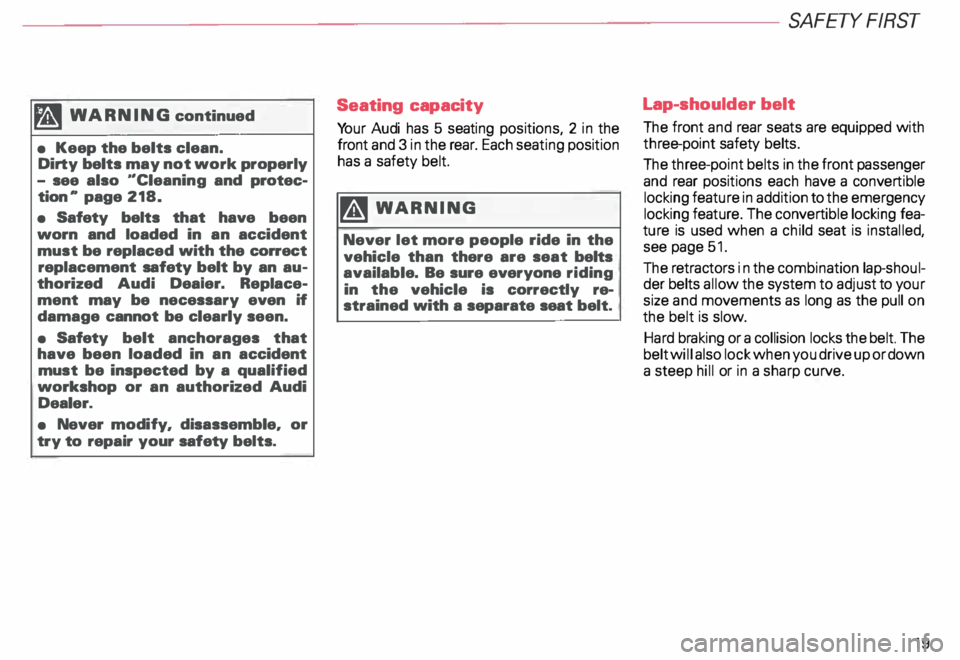
fh1
WARNING continued
• Keep the belts clean.
Dirty belts may not work properly
- see also .. Cleaning and protec
tion .. page 218.
• Safety belts that have been
worn and loaded in an accident
must be replaced with the correct
replacement safety belt by an au
thorized Audi Dealer. Replace
ment may be necessary even if
damage cannot be clearly seen.
• Safety belt anchorages that
have been loaded in an accident
must be inspected by a qualified
workshop or an authorized Audi
Dealer.
• Never modify. disassemble, or
try to repair your safety belts. Seating capacity
Your Audi has 5 seating positions, 2 in the
front and 3 in the rear. Each seating position
has a safety belt.
�W ARNING
Never let more people ride in the
vehicle than there are seat belts
available. Be sure everyone riding
in the vehicle is correctly re
strained with a separate seat belt. SA
FETY FIRST
Lap- shoulder belt
The front and rear seats are equipped with
three-point safety belts.
The three-point belts in the front passenger
and rear positions each have a convertible
locking feature in addition to the emergency
locking feature. The convertible locking fea
ture is used when a child seat is installed,
see page 51.
The retractors in the combination lap-shoul
der belts allow the system to adjust to your
size and movements as long as the pull on
the belt is slow.
Hard braking or a collision locks the belt. The
belt will a I so lock when you drive up or down
a steep hill or in a sharp curve.
19